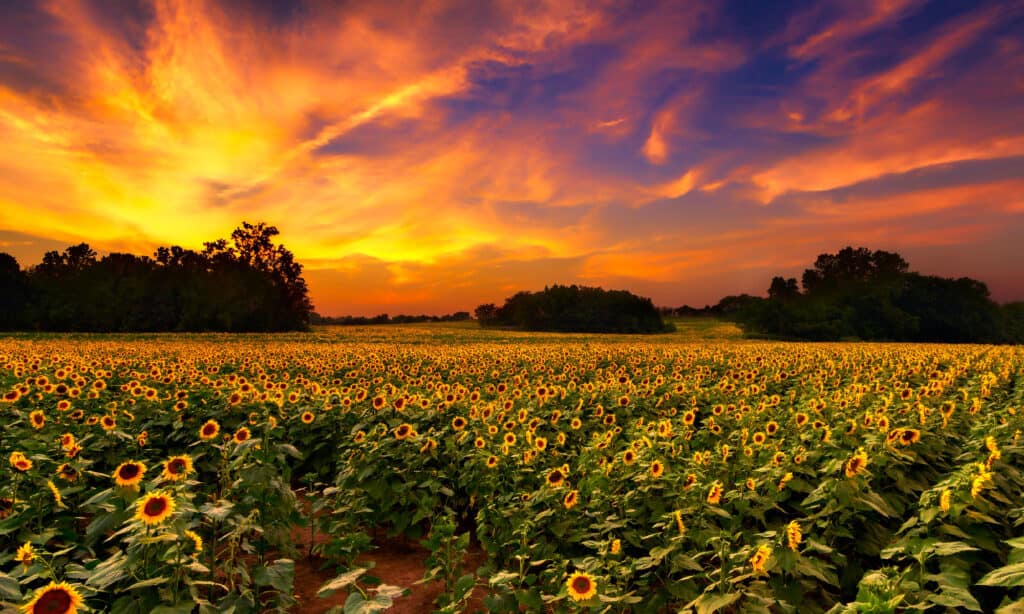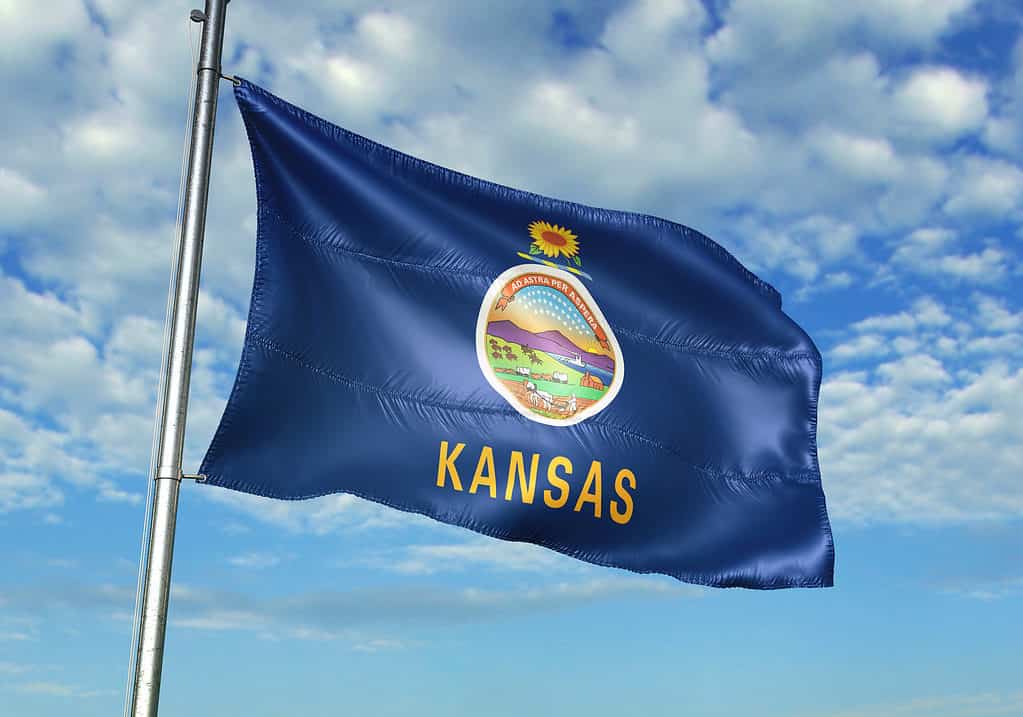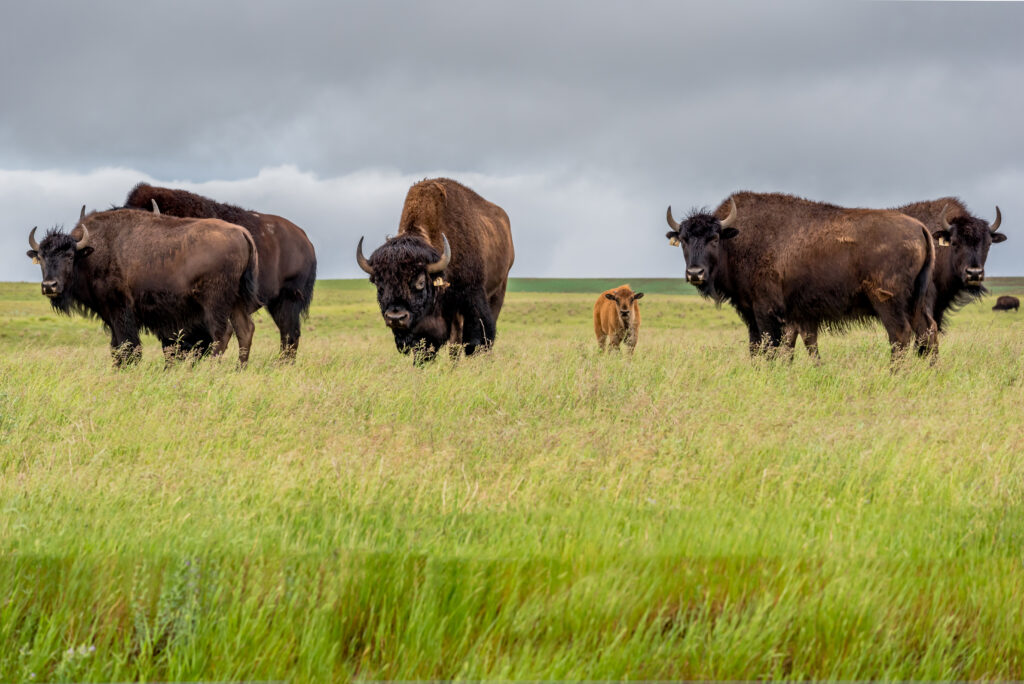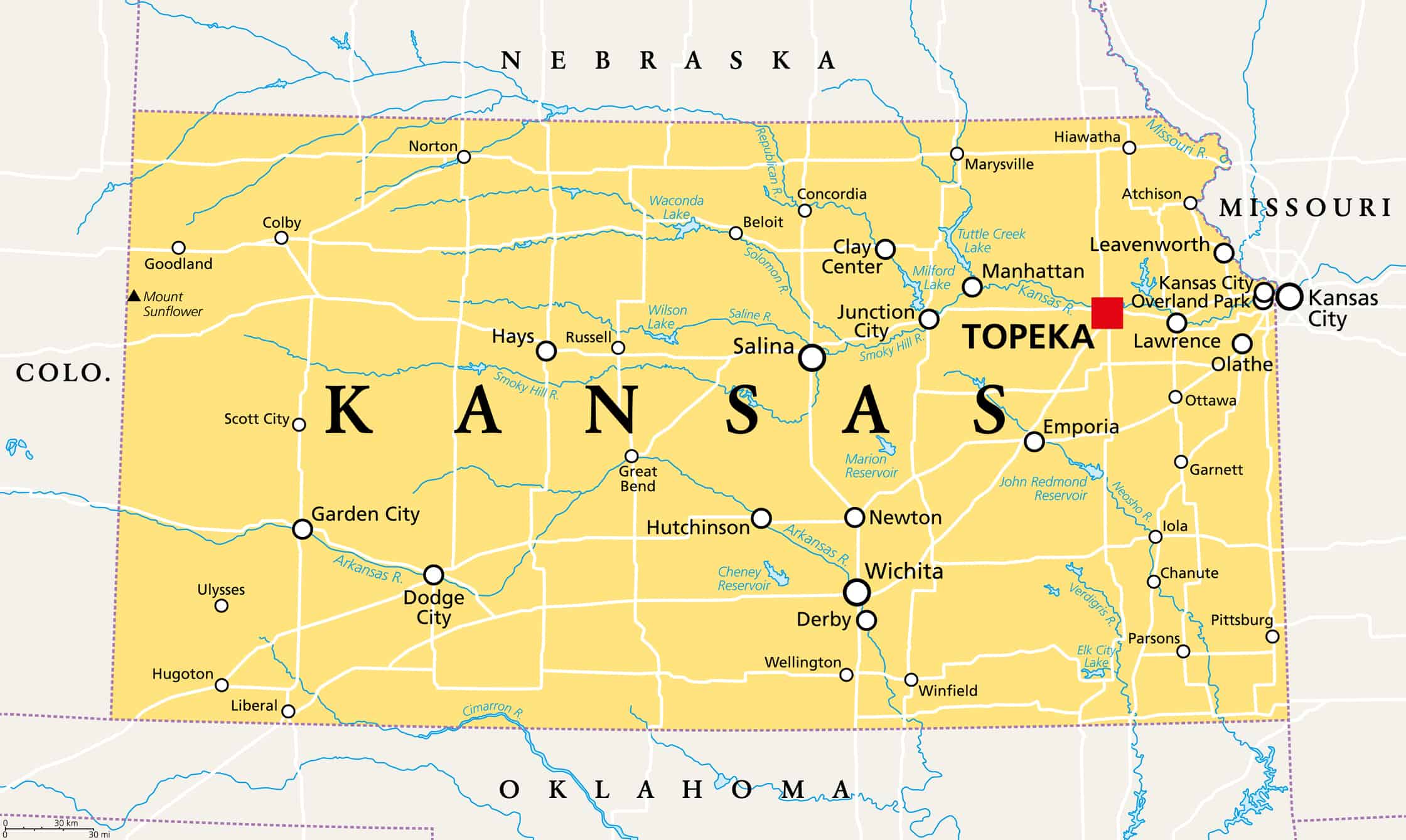A lot of people don’t know much about Kansas. This midwestern state doesn’t get much attention from the world, aside from a movie quote here and there. Kansas doesn’t boast steep cliffs and a plethora of waterfalls, but its humble beauty and interesting history make it a place worth visiting. A visitor staring for miles over the famous vast plains of Kansas might wonder about the “Sunflower State.” Many questions come to mind when considering places we don’t know. Who lives there? What do they do for work? Do they like it?
We have some other questions we’re going to answer. When did Kansas become a state? What wildlife lives in the state? What’s the lowest point? Let’s explore all of that – and maybe a little more – now.
A Brief Indigenous History of Kansas

The plains of Kansas are covered in wild sunflowers which is how it earned the nickname “The Sunflower State.”
©iStock.com/tomofbluesprings
The great plains and prairies of Kansas used to be perfect homes for roaming buffalo. It was also great for now-extinct Ice Age animals, such as mammoths, ground sloths, camels, and horses. But wait, aren’t camels and horses still around? Yes, but they are not the same as the horses and camels in this era. Camels no longer live natively in North America, but they did once roam free across the nation.
It was around 7,000 BC when the first human inhabitants reached Kansas. These paleolithic descendants of early Asian immigrants took a great liking to Kansas and decided to stay. Their tribes mingled with other migratory tribes that came to the area and a new era of Indigenous history was born. Unfortunately, some history isn’t pleasant. Many of the tribes in the area specialized in large game hunting – and they were quite good at it. Soon enough, mammoths, camels, and those historic wild horses were all wiped from the earth as a result of overhunting.
This extinction hailed a new era for the hunter-tribes in Kansas. Many left with the extinction of big game, while others transitioned to new ways of life to survive. These new ways of life contained more movement and balance. The remaining tribes added foraging to their culture and ate a diet of foraged food, small game, and some large game. They moved across the plains of Kansas with the seasons to accommodate their lifestyles and the lands that fed them.
Agriculture and the City-Builders
As time went on, Indigenous tribes became more resourceful and creative. Archaic groups began their transition from food gathering to food production as many as 3,000 years ago. This led to the first boom in the maize (corn) agricultural field. Harvesting crops means you have to stay by them to tend them as they grow. It is no wonder that the history of permanent Native settlements began to arise at the same time.
It is important to note that the development of agriculture did not cause the native people of Kansas to lose touch with their hunter-gathering. Not only had they not mastered tending the lands yet, but the new crops were meant to be supplemental, not all-encompassing. No archaic society ever completely abandoned hunter-gathering. This is a keen note on tradition and an appreciation for a people who demanded to stay in touch with their natural world.
However, many tribes were no longer as nomadic as they once were. Archaeological evidence and explorer journals capture an incredible scene – the city of Etzanoa. This ancient city is thought to have had as many as 20,000 residents, and it stood near the location of present-day Arkansas City.
European Exploration and Statehood

On January 29th, 1861, the United States Union admitted Kansas as the 34th state.
©iStock.com/Oleksii Liskonih
Europeans explored Kansas as early as the 1500s. One Spanish conquistador found Kanses in 1541 and began interacting with the Indigenous Tribes that now occupied the area. These tribes, the ancestors of the Pawnee and Witchita people, saw men riding horses for the first time. This completely changed the lives of the Plains Natives. Many other tribes inhabited the state and ended up responsible for the end of the Spanish expedition in the area. After a series of vicious battles, Spanish explorers left Kansas for someone else to explore.
Kansas was mostly ignored after that. It was never a particularly important part of any land purchase, though most of it was relegated to Native Lands from the 1820s to the 1850s. The Indigenous people of the plains were deeply impacted by the Indian Removal Act of 1830. This act was in direct contention with the original treaties that gave the Native people their lands. By the 1850s, everything in Kansas changed. Most Indigenous tribes ceded their lands to the United States, clearing the way for European settlement. The settlers erected several forts and developments in the area and now focused on slavery.
Several battles took place over slavery and included fights with the remaining Indigenous tribes. Politically, the situation was also a mess. Several constitutions were pushed for Kansas before the state found peace, including the Topeka, Lecompton, Leavenworth, and Wyandotte Constitutions. Finally, Kansas found peace as an anti-slavery state in 1859.
On January 29th, 1861, the United States Union admitted Kansas as the 34th state.
What is the Lowest Point in Kansas?
The lowest point in Kansas is the Verdigris River. It rests at an elevation of 679 feet above sea level at its lowest point. This low point sits near Coffeyville in Kansas, right by the border of Oklahoma.
This low elevation point is in contrast with the state’s highest point – Mount Sunflower. Mount Sunflower is not a true mountain but it still rises 4,039 feet above sea level. That means there’s about a 3300-foot difference between the two points.
The Verdigris River on a Map
We’ve included an interactive map that shows Coffeyville, Kansas. You can see on the map that the Verdigris River flows east of Coffeyville and south into Oklahoma.
About the Verdigris River
The Verdigris River is a 310-mile-long tributary of the Arkansas River. It begins near Madison, Kansas at the confluence of two headstreams. It then runs its course through Kansas and into Oklahoma, where it joins the Arkansas River near Muskogee. The waters will then flow to the Mississippi River, contributing to the largest watershed in North America.
Verdigris is a word that means green-gray in French. “Vert” means green and “Gris” means gray. Its name was established in 1834 during a treaty agreement with the Cherokee.
Is the Verdigris River Safe to Swim in?
You can swim at some points of the Verdigris River, including at Verdigris River Park. This park has a free campground and nearby access to Oologah Lake. This park rests in Oklahoma and is managed by the Army Corps of Engineers. We have no verifiable information on the safety of swimming in the Kansas portion of the Verdigris River. Many counties in Kansas actively support fishing and boating in its waters, but usually recommend nearby lakes for swimming.
What we do know is that the waters flow into the Arkansas River, which is not safe to swim in.
Visiting the Lowest Point in Kansas
If you’re curious about the life and culture around the lowest point in Kansas, you can absolutely visit Coffeyville. Coffeyville is the largest city in Montgomery County, Kansas, boasting a population of 8,847. It is mostly a small college city, but it does contain a few notable attractions. There are a number of historic buildings, including the Midland Theatre and the Perkins Building.
A couple of museums share the history of the area, like the Aviation Heritage Museum, the Brown Mansion, and the Dalton Museum. You can learn all about a group of Wild West Outlaws called the Dalton Gang. Their last robbery happened in Coffeyville, Kansas in 1892. The city is happy to share history with you, while offering some great outdoor recreation, as well.
The city actually boasts 11 different city parks, including Cartwright Park, Pfister Park, Grace Park, and Harmon Park.
Wildlife in Kansas

One of the largest mammals in the state, the Bison, is also the state animal.
©Nancy Anderson/Shutterstock.com
Wildlife abounds in Kansas, despite the risks of tornados and other disasters that make existence difficult. The Verdigris River actually claims some fame in the fish and fishing department. Many trophy catfish and sand bass have been pulled from the river. The river also contains paddlefish, striped bass, crappies, gar, walleye, and trout.
The state hosts white-tail deer, raccoons, bobcats, prairie dogs, and muskrats. You can also find beavers, bats, chipmunks, squirrels, opossums, and groundhogs. One of the largest mammals in the state, the Bison, is also the state animal.
The bird population is rich, as well. Several bird species join the state bird, the meadowlark, in living in and celebrating all that Kansas has to offer. These birds include species such as the American goldfinch, blue jay, downy woodpecker, Northern flicker, yellow-rumped warbler, and purple martin.
Thank you for reading! Have some feedback for us? Contact the AZ Animals editorial team.








